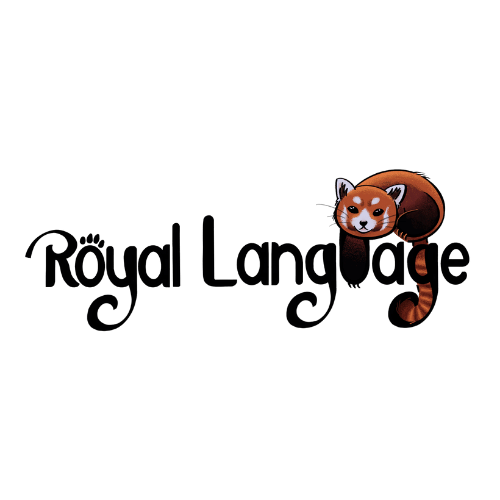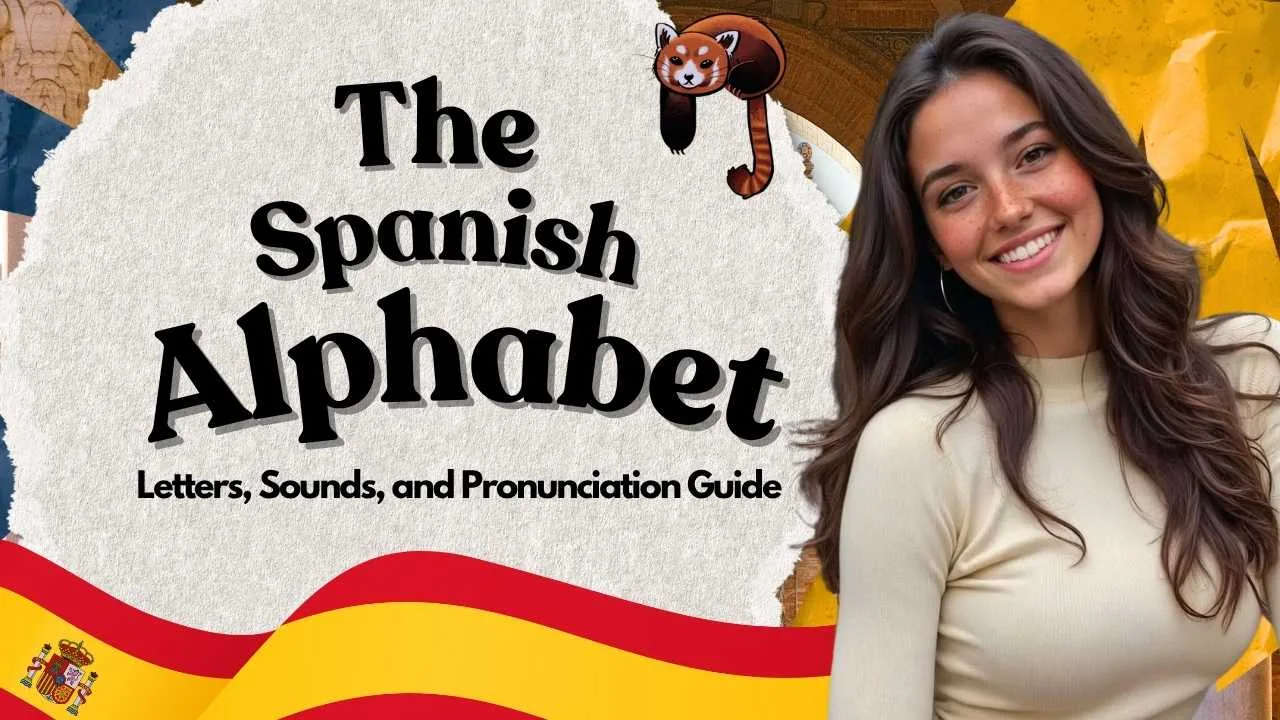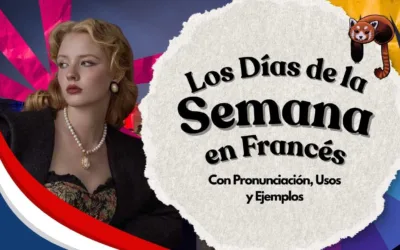🇪🇸 The Spanish Alphabet: Letters, Sounds, and Pronunciation Guide
Learning the Spanish alphabet (el alfabeto español) is the perfect way to start your Spanish journey. It’s the foundation of reading, writing, and pronunciation — and it opens the door to understanding how the language sounds and works.
The Spanish alphabet has a fascinating history that traces back to the Latin alphabet used by the ancient Romans. As the Spanish language evolved from Vulgar Latin during the Middle Ages, its alphabet began to incorporate unique sounds and symbols to represent new phonetic realities — the most famous being Ñ, a letter born in medieval monasteries when scribes placed a small “n” over another “n” (nn → ñ) to save space in manuscripts.
Over time, Spanish spread across continents, and so did its alphabet — influencing and being influenced by regional variations in pronunciation, from Spain to Latin America and beyond.
Today, the modern Spanish alphabet consists of 27 letters, just one more than English. Until 2010, “CH” and “LL” were officially part of the alphabet, but the Royal Spanish Academy decided to classify them as digraphs (combinations of two letters) rather than independent letters.
In short: learning the Spanish alphabet is not only about memorizing letters — it’s about discovering how history, culture, and sound shape the language itself.
📌 The Spanish Alphabet (El Abecedario en Español)
The Spanish alphabet is made up of 27 letters:
A – B – C – D – E – F – G – H – I – J – K – L – M – N – Ñ – O – P – Q – R – S – T – U – V – W – X – Y – Z
👉 Although many letters look the same as in English, several of them sound completely different. Below, you’ll find a detailed guide with pronunciation and examples to help you sound like a native speaker.
🎧 Listen to the Spanish Alphabet
To improve your pronunciation, it’s highly recommended to listen and repeat the Spanish alphabet. You can find plenty of videos and recordings online or on YouTube, including fun versions of the Spanish alphabet song.
👉 Tip: Repeat the alphabet aloud several times a day, just like singing a song! This is especially useful for children and complete beginners who are still developing an ear for Spanish sounds.
⚠️ Attention: The speaker icon 🔊 to listen to the words or phrases works best in Google Chrome, Microsoft Edge, or Safari. In other browsers, the Royal Language audio service may not be available or may sound different.
| Letter | Letter's name | afi | Spanish vocabulary |
|---|---|---|---|
| A | a 🔊 | /a/ | abeja (bee) 🔊 |
| B | be 🔊 | /be/ | barco (boat) 🔊 |
| C | ce 🔊 | /θe/ or /se/ or /ke/ | casa🔊 (house), cielo🔊(sky) |
| D | de 🔊 | /de/ | dado (dice) 🔊 |
| E | e 🔊 | /e/ | elefante (elephant) 🔊 |
| F | efe 🔊 | /ˈefe/ | flor (flower) 🔊 |
| G | ge 🔊 | /xe/ or /ge/ | gato 🔊(cat), gente 🔊 (people) |
| H | hache 🔊 | /ˈatʃe/ (silent) | hola (hello) 🔊 |
| I | i 🔊 | /i/ | iglesia (church) 🔊 |
| J | jota 🔊 | /xota/ | jugo (juice) 🔊 |
| K | ka 🔊 | /ka/ | kilómetro 🔊 (kilometer) |
| L | ele 🔊 | /ˈele/ | libro 🔊 (book) |
| M | eme 🔊 | /ˈeme/ | mano 🔊 (hand) |
| N | ene 🔊 | /ˈene/ | nube 🔊 (cloud) |
| Ñ | eñe 🔊 | /ˈeɲe/ | niño 🔊 (child) |
| O | o 🔊 | /o/ | oso 🔊 (bear) |
| P | pe 🔊 | /pe/ | perro 🔊 (dog) |
| Q | cu 🔊 | /ku/ | queso 🔊 (cheese) |
| S | ese 🔊 | /ˈese/ | sol 🔊 (sun) |
| T | te 🔊 | /te/ | taza 🔊 (cup) |
| U | u 🔊 | /u/ | uva 🔊 (grape) |
| V | uve 🔊 | /ˈuβe/ | vaca 🔊 (cow) |
| W | doble u 🔊 | /ˈdoβleˈu/ | wifi 🔊 (Wi-Fi) |
| X | equis 🔊 | /ˈekis/ or /x/ | xilófono 🔊 (xylophone), México 🔊 |
| Y | ye o i griega 🔊 | /ʝe/ or /ʎe/ | yo 🔊 (I) |
| Z | zeta 🔊 | /θeta/ or /seta/ | zapato 🔊 (shoe) |
🔤 Spanish Pronunciation Explained (for English Speakers)
Understanding how to pronounce the Spanish alphabet correctly is key to speaking clearly and naturally. Unlike English, Spanish is a phonetic language, meaning that words are generally pronounced exactly as they are written — once you know the sound of each letter, you can read almost anything!
Below you’ll find a detailed explanation of how each letter sounds, what makes it different from English, and how regional variations may affect pronunciation.
A /a/
-
Pronounced like “ah” in father or car.
-
It’s an open and pure sound, never changing to ei or æ like in English.
-
Example: amigo, gato, casa.
🗣️ Tip: Open your mouth wider than you would for English vowels.
B /b/
-
Sounds like the English “b” at the start of a word (bueno, buscar).
-
Between vowels, it’s softer, almost like a mix between b and v: lobo → [ˈloβo].
-
The lips touch gently, not with a strong burst of air.
-
In Spanish, “B” and “V” sound almost identical.
C /θ/ or /s/ or /k/
-
Before E or I →
-
In Spain: pronounced /θ/ like th in think → cielo, cinco.
-
In Latin America: pronounced /s/ → cielo, cine.
-
-
Before A, O, U → /k/ → casa, color, cuchillo.
-
Important: Never sounds like English ch or sh.
D /d/
-
At the beginning of a word, it’s similar to English “d” → día, dedo.
-
Between vowels, it’s softer: cada sounds like [ˈkaða].
-
At the end of words (especially in Spain), it can sound like th: usted → [usˈteð].
E /e/
-
Pronounced like “e” in met, red.
-
Always pure, never ee or ay as in English.
-
Example: elefante, mesa, verde.
🗣️ Tip: Keep your tongue lower and jaw slightly open.
F /f/
-
Same as English “f”.
-
Always soft, not aspirated (no puff of air).
-
Example: flor, familia, foto.
G /g/ or /x/
-
Before A, O, U → hard g like go → gato, goma, gusto.
-
Before E, I → soft guttural sound /x/ like the h in ham but stronger → gente, girar.
-
To keep the hard sound before E or I, add U: guerra, guitarra.
🗣️ Tip: The sound /x/ comes from the back of the throat, similar to German “Bach”.
H (silent)
-
Always silent in Spanish.
-
hola → “ola”, huevo → “uevo”, hablar → “ablar”.
-
There is no aspiration like English h.
👉 Remember: Spanish words never start with a pronounced “h”.
I /i/
-
Pronounced like “ee” in see or machine.
-
Never sounds like ai as in time.
-
Example: isla, iglesia, niño.
J /x/
-
Strong, throaty /x/ sound (like Scottish loch or German Bach).
-
Example: jugo, jamón, jirafa.
🗣️ Tip: English speakers often make it too soft — it should vibrate in the throat.
K /k/
-
Rare in native words; found in loanwords → kilómetro, karaoke, kiwi.
-
Always pronounced as a hard k, never like ch.
L /l/
-
Same as English “l”, but clearer and lighter.
-
Example: luz, lápiz, sol.
🗣️ Avoid the “dark L” of English words like full or milk.
LL /ʝ/ or /ʎ/
-
Traditionally /ʎ/, like the lli in million (Spain, Andes).
-
In most of Latin America → pronounced /ʝ/, like English y in yes: llave, lluvia.
-
In Argentina and Uruguay → often sounds like /ʒ/ or /ʃ/ (zh sound): lluvia → zhubia.
M /m/
-
Same as English “m”: mano, mamá, comida.
-
Clear and nasal, always pronounced.
N /n/
-
Same as English “n”, but adapts its sound slightly before other consonants:
-
Before “p” or “b”: becomes [m] (un beso).
-
Before “g” or “k”: becomes [ŋ] (tengo).
-
Ñ /ɲ/
-
Unique to Spanish!
-
Sounds like “ny” in canyon or onion.
-
Example: niño, España, año.
🗣️ Tip: Smile slightly; the sound flows through the nose.
O /o/
-
Like “o” in more but shorter and pure.
-
Never sounds like ou or uh.
-
Example: oso, coche, color.
P /p/
-
Same as English “p”, but no puff of air (no aspiration).
-
Example: pelo, papa, parque.
🗣️ In English you blow air after “p”, in Spanish you don’t.
Q /k/
-
Always followed by UE or UI and sounds like K: queso, quitar, pequeño.
-
The U is silent → que = “keh”, qui = “kee”.
R /ɾ/ and 🆁🆁 RR /r̄/
-
Single R (soft) → quick tap of the tongue, like butter in American English: caro.
-
Double RR (rolled) → strong trill: perro, guitarra.
-
At the start of a word, R is always rolled: rosa, rápido.
🗣️ Practice by repeating “tttt” fast to feel the tongue tap.
S /s/
-
Clear s, never like English z.
-
Example: sol, casa, mesa.
-
No buzzing sound — keep it clean and hissing, not voiced.
T /t/
-
Similar to English, but softer and dental (tongue touches teeth).
-
Example: taza, tomate, triste.
🗣️ Do not aspirate (no puff of air).
U /u/
-
Like “oo” in food.
-
Never sounds like you or uh.
-
Example: uva, luna, mundo.
-
When preceded by “G” or “Q”, it can be silent: guitarra, queso.
-
With a diéresis (ü), it’s pronounced: pingüino, vergüenza → [u].
V /b/
-
Sounds exactly like B in modern Spanish: vaca, volver, vivir.
-
Historically they were distinct, but not anymore.
-
Lips touch lightly, not pressed.
W /w/
-
Appears only in foreign or technical words: whisky, wifi, waterpolo.
-
Usually pronounced like English w, or sometimes b in Spain.
X /ks/ or /x/
-
Normally /ks/ like xilófono.
-
In some names, /x/: México, Oaxaca.
-
Historical spelling from old Spanish (originally Méjico).
Y /ʝ/ or /i/
-
As a consonant → /ʝ/ like yes: yo, yema.
-
As a vowel (when alone or at the end of a word) → /i/: y (and), hoy, rey.
-
In Argentina/Uruguay → zh sound.
Z /θ/ or /s/
-
In Spain: /θ/ like th in think → zapato.
-
In Latin America: /s/ → zapato, zona.
-
Never sounds like English zoo.
🎙️ Key Sound Differences Between Spanish and English
| Type | Spanish Sound | English Equivalent / Note |
|---|---|---|
| Vowels | Always pure and short | English vowels change in quality; Spanish ones don’t |
| B/V | Same sound /b/ or /β/ | English distinguishes B and V |
| C/Z | /θ/ or /s/ | English “c” can be /s/ or /k/, but not exactly like Spanish |
| G/J | /x/ | Stronger than English h |
| H | Silent | Always pronounced in English |
| R/RR | Tapped or rolled | English never rolls the R |
| LL/Y | /ʝ/, /ʎ/, or /ʒ/ | English y similar, but varies regionally |
| T/P | No aspiration | English t, p have air puff |
| X | /ks/ or /x/ | “México” unique pronunciation |
🧠 Pronunciation Tips for Beginners
-
Avoid English habits: Don’t add extra vowel sounds at the end of consonants (no es-pan-ishuh).
-
Listen daily: Native audio helps internalize rhythm and accent.
-
Speak slowly: Focus on accuracy, not speed.
-
Use tongue position: Spanish consonants are more dental (closer to teeth).
-
Repeat minimal pairs: Practice pero/perro, casa/caza, baca/vaca.
Keywords
the spanish alphabet lore, the spanish alphabet, the spanish alphabet song, the spanish alphabet pronunciation, the spanish alphabet sounds, how many letters has the spanish alphabet, alphabet in spanish, the spanish alphabet chart, youtube spanish alphabet, video alphabet in spanish, Spanish alphabet pronunciation, Portuguese alphabet, Spanish Alphabet Song, French alphabet, ABC Spanish, Spanish Alphabet Lore, Spanish letter, Spanish to English, how many letters are in the spanish alphabet, how many letters are there in the spanish alphabet, how many letters does the spanish alphabet have, how to pronounce the spanish alphabet, how to say the spanish alphabet, what letter in the spanish alphabet is never pronounced, how do you say alphabet in spanish, y in the spanish alphabet, sounds of the spanish alphabet, letters in the spanish alphabet
Estudia Con Nosotros de Manera Online
Revista Virtual
Los Artículos Indefinidos en Idioma Alemán: Ein, Eine, Kein, Keine
🧩 Los artículos indefinidos en alemán: ein, eine, einen... En alemán, además de los artículos definidos (der, 🔊 die, 🔊 das 🔊), existen también los artículos indefinidos, que usamos cuando hablamos de algo no específico o no conocido.En español equivalen a “un, una,...
Los Días de la Semana en Francés: Pronunciación, Usos y Ejemplos
Los días de la semana en francés: guía completa para principiantes Aprender los días de la semana en francés es uno de los primeros pasos para comunicarte en situaciones cotidianas. Dominar este vocabulario básico te permitirá hablar de tus rutinas, organizar...
Los Artículos Definidos en Idioma Alemán: Der, Die, Das
🧩 Los artículos definidos en alemán: “der” , “die” y “das” Uno de los primeros retos para los estudiantes de alemán es aprender los artículos definidos, ya que en este idioma cada sustantivo tiene género gramatical (masculino, femenino o neutro), y además el artículo...
Mantente Informado de las Últimas Noticias y Actualizaciones
Inscríbete a Nuestros Cursos Online
C️oreano - ️Francés -️ Japonés
Inglés -️ Italiano - Alemán - Chino
Ruso - Portugués - Árabe - Noruego
Únete a Nuestro Newsletter
Enteráte de nuestros nuevos artículos sobre lengua y cultura.
Síguenos
En totdas nuestras redes sociales






